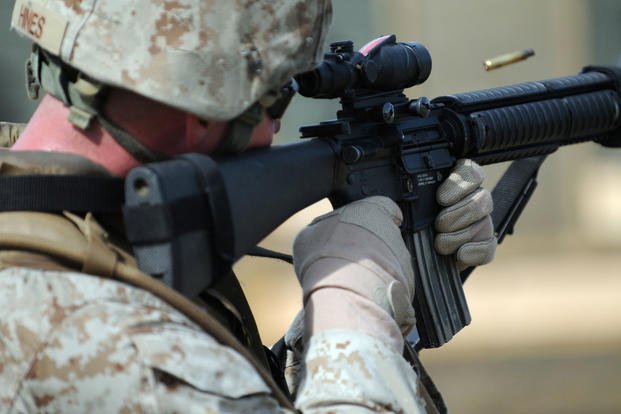Unlike the other branches, Marine recruits qualify with the same M16 rifle they've been carrying around with them throughout the entire basic training course. Therefore, you should treat your rifle well every day to make sure that it's in good shape for qualification day.
The Marine Corps basic training marksmanship course consists of three distinct phases.
Phase 1: Weapons Introduction
During this phase, you find out all about the M16A2 rifle. You're even required to memorize your particular rifle's serial number. You spend a considerable amount of time taking your rifle apart, cleaning it and putting it back together. You're also required to memorize the four rules of Marine Corps rifle safety:
- Treat every weapon as if it were loaded.
- Never point your weapon at anything you do not intend to shoot.
- Keep your finger straight and off the trigger until you intend to fire.
- Keep your weapon on safe until you intend to fire.
You also will learn another weapons safety rule when you get out of basic training: Be absolutely sure of your target and what is behind it.
During Marine Corps basic training, you must never refer to your M16 as a gun. Doing so will result in a massive tirade from your drill instructor. MarineCorps M16s are always called your weapon or your rifle.
During the first phase, you'll also receive several hours of classroom instruction on proper marksmanship techniques so that you'll be able to hit the target when the time comes.
Phase 2: Snap-in/Grass Week
During snap-in week, you're primarily in a classroom setting where you learn the four standard Marine Corps firing positions (standing, kneeling, sitting and prone). This phase of your training isn't conducted by a drill instructor but rather by a Marine who holds the MOS (military occupational specialty, or job) of a primary marksmanship instructor (PMI).
The PMI teaches you how to adjust your sights, how to adjust for weather conditions and how to successfully hit what you're aiming at. During this phase of training, you actually get to fire a computerized version of your weapon, which will give you a good indication of how you'll do when you actually visit the firing range.
Phase 3: Firing Week
During firing week, you actually get to fire your weapon for the first time. The week begins with practice on the firing range. Half of your platoon will fire the weapon, while the other half sets up targets. Then you swap.
The course of fire includes shooting at targets that are 200, 300 and 500 yards away from the prone, sitting, kneeling and standing positions. It's interesting to note that the Marine Corps is the only branch that has recruits shooting from distances as far as 500 yards away.
At the end of the week, you get a chance to fire on the actual qualification course. The course is the same as the one you used in practice, but this time, it counts. If you fail to qualify, you won't proceed in basic training with the rest of your platoon. You'll be sent back to complete rifle instruction all over again, thereby delaying your graduation date.
In order to qualify, you fire a total of 50 rounds, worth up to five points each (depending on where you hit the target). The maximum possible points you can earn on this course is 250. To pass the course, you must earn at least 190 points, which will qualify you to wear the Marine Corps marksmanship badge. To become a sharpshooter, you must earn at least 210 points. In order to win status as an expert, you must receive a score of at least 220 points.
From Basic Training for Dummies, copyright © 2011 by Wiley Publishing, Inc., Hoboken, New Jersey. Used by arrangement with John Wiley & Sons, Inc.
Interested in Joining the Military?
We can put you in touch with recruiters from the different military branches. Learn about the benefits of serving your country, paying for school, military career paths, and more: sign up now and hear from a recruiter near you.















